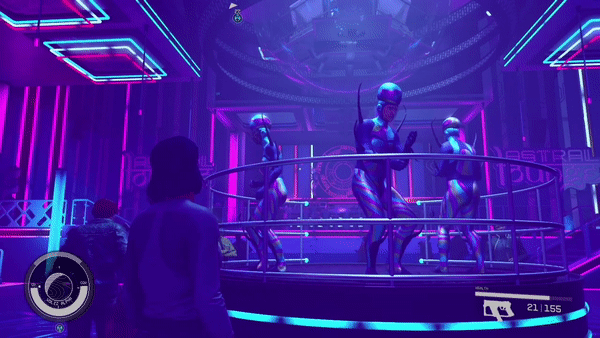Starfield is a buggy, frustrating mess, but I love it anyway
306613 












Starfield is a pile of mismatched puzzle pieces that don’t quite fit together. That might sound like harsh criticism, but there are plenty of times when its disjointed nature works in the game’s favor. There are a million things to do in Starfield at any given point in time, so when one aspect of the game wasn’t working for me, I could just focus on something else.
Directing my attention towards a specific gameplay mechanic or subplot usually made Starfield more entertaining, but it didn’t necessarily make it any less overwhelming. There’s so much going on that characters are constantly talking over each other, even during crucial story segments. If I happened to walk through a crowded location, I’d usually walk away with a pile of new quests.

The worlds of Starfield
And Starfield isn’t just bursting at the seams with content. It can feel like a totally different game based on which part of the universe you happen to be visiting. The first metropolis I traveled to was New Atlantis, the capital of the United Colonies. It’s sterile, corporate, and makes the game seem much more boring than it actually is. After I completed a few quests,I found myself in Cydonia, an underground hellhole where conversations are frequently interrupted by earthquakes.
Every major location in Starfield feels like a different subgenre of sci-fi. New Homestead, a tourist trap where people try to live like old-timey space colonists, is straight out of an old issue Analog. Akila City, a wild west town plagued by space wolverines, belongs in an episode of Firefly. My favorite city, Neon, is a seedy cyberpunk dystopia where I could do it all: use illegal psychedelics, watch guys awkwardly dance in alien costumes, or get a job shuffling files in a corporate office.

Of course, some of my best Starfield play sessions haven’t involved cities at all. Not only does it have more than one thousand planets to explore, but it let me transform those mostly empty worlds into whatever I wanted them to be. I spent way too many hours playing Starfield like it was a space-age Harvest Moon. I built greenhouses, gathered ingredients, tamed alien critters, and collected adorable plushies to display at my outpost.
Starfield struggles to find a stable identity
At its best, Starfield feels like a giant toy box. Sometimes I’d play with my spaceman action figures, other times I’d focus on my animal figurines, and sometimes I’d mix everything together and have an absolute blast. But there are also times when the disconnected nature of Starfield made the whole thing fall apart. During these moments, it felt more like a theme park ride that I couldn’t get off, even when I wasn’t having fun anymore.

Starfield never manages to be an immersive space sim. There’s an artificiality to it that makes it all seem constructed. The world-building borders on nonexistent. Different planets feel like they’re galaxies apart, but I still spotted the exact same posters hanging on walls. Even the NPCs feel like animatronics reciting dialogue while making strange, unnatural facial expressions.
It’s a game that offers seemingly endless freedom until it doesn’t. Everything is an illusion, and sometimes, it’s too easy to spot the strings holding things up. All interstellar navigation is designed to be handled through fast travel, so I spent more time looking at menus and loading screens than staring at the stars. Sure, I could have opted to take the slow route, but players have tested it and found it doesn’t really work.

Starfield isn’t just overly reliant on fast travel; it also takes it away at the most inconvenient moments. During long quests, I occasionally wanted to pop back to my ship or a nearby city so that I could restock on ammo or healing items. When I tried to do that, I was presented with a message telling me that I couldn’t fast travel from that location.
There are plenty of games that don’t let you leave a location when you’re in the middle of a quest, but Starfield doesn’t actually do that. I could still walk back to my ship, fly away, and walk back in when I was ready to resume the quest. I was never actually locked into a specific location; Starfield just made it more of a hassle for me to leave.

Starfield’s gameplay: restrictive and messy for no real reason
That pointless restrictiveness is common in Starfield, even though the constraints are usually an illusion. Many early story quests forced me to pair up with a specific companion, and it often felt like I was being saddled with a long list of tasks. I was free to avoid those tasks and do my own thing, but it felt like I was skipping out on something important.
When I chose to ignore the call of adventure for a while, it wasn’t easy to get back to it either. Starfield’s first hour or so is an onslaught of tutorials—tutorials for mining, combat, hailing and docking spaceships, and every other gameplay mechanic I might eventually want to know about. It’s a mess of overlapping systems, and by the time I actually wanted to use them, I’d forgotten how they work. Sometimes I found myself frantically googling things like “How do I use a flashlight?” in the heat of battle.

Starfield is undeniably ambitious, but so many of its ideas feel half-baked or poorly executed. I know that Todd Howard claims the lack of ground vehicles was a deliberate choice, but it feels absurd to take a giant spaceship to an unknown destination only to walk everywhere on foot. Planets are pretty empty, and so many of the locations that are there feel like filler. I can only shoot so many spacers and visit so many abandoned research stations before I start to get bored.
The combat in Starfield is solid enough, but it rarely feels exciting. Most enemies can soak up lots of bullets, so I ran out of ammo pretty quickly. I constantly found myself pausing the action while I rifled through my inventory in search of a weapon I actually had bullets for. Battles felt a lot better once I picked up some new weapons and upgraded my skills, but fighting was never my favorite part of the game.

The bugs and technical problems of Starfield
And beyond that, Starfield has all the clunkiness I’ve grown to expect from Bethesda games. The lack of polish is sometimes funny, like when a shop stores its entire inventory in a mud puddle, but it can also be incredibly annoying.
My game crashed so many times that I got in the habit of saving every few minutes. Companions were constantly blocking my view or walking directly into my line of fire. Sometimes, NPCs stood on top of each other, which meant I had to stare at the wrong person while I talked to someone else about a quest. (Okay, that was pretty funny too.)

How Starfield won me back: fun quests and memorable NPCs
But here’s the thing about Starfield: Every single time it lost me, it managed to win me back. It might be a theme park ride, but it’s a roller coaster, and for every low, there’s a soaring, phenomenal high. It doesn’t always pull off the spectacle of space, but it excels at the mundane. I relished these smaller moments. One time I walked into a store and saw the shopkeep cracking jokes at his disinterested robot assistant. I spent an absurd amount of time following around a random NPC as he excitedly took me on a guided tour.
Not every quest is a winner, but Starfield still has some of the best sidequests I’ve seen in a Bethesda game since Fallout 3. There were times when the main campaign was pretty enthralling, but there are also some incredible hidden quests that are easy to miss. (No spoilers, but don’t skip the “Operation Starseed” quest; it was a highlight of my playthrough.)

Starfield does have a lot in common with Fallout 4—the combat is basically identical—but it also improves upon it in critical ways. I don’t think it’s possible to play the entire game as a pacifist, but there are tons of opportunities to avoid violence. Once I put a few points into persuasion, I was able to talk down bank robbers and charm my way into enemy quarters. I was even able to talk my way out of the game’s final battle.
And while the game can feel sterile, it’s still filled with surprises and moments of discovery. Even after seventy-plus hours of play, Starfield is still finding ways to catch me off guard. Early in the game, a strange ship hailed me mid-battle. When I picked up, I was greeted by a salesperson that wanted to talk to me about my ship’s warranty. I politely ended the call, but dozens of hours later, after I’d forgotten all about it, he contacted me again and asked if I’d had enough time to consider my warranty options.

One time I was hailed by a ship full of tourists that proceeded to ask me weird and embarrassing questions. Sometimes, I got calls from strangers that just wanted to chat. There were times when I’d do something by accident, like steal a bottle of whiskey, and kick off something crazy, like getting arrested by space cops that promised to make my rap sheet disappear if I did some undercover work.
Some locations were boring, sure, but I never knew when I’d stumble onto an abandoned zero-gravity casino or a paper clip factory that had been taken over by a rogue AI (a clever reference to a great browser game, perhaps). Other locations had floor puzzles and trapdoors that led me to mind-blowing secrets. Even after all this time, I’ve only seen a fraction of Starfield, so I’m sure there are still plenty of discoveries ahead of me.

I don't want to stop playing Starfield
Despite all the bugs and moments of tedium, I never felt and still don’t feel bored with Starfield. As I was nearing the end of the game, I was excitedly talking about all the things I wanted to do in my next playthrough. It doesn’t hurt that the game has a genuinely novel take on New Game Plus. Even after the credit rolled, I wasn’t ready to put the game down.
It might sound like I’m just making excuses for Starfield’s obvious shortcomings, and I guess I am, but this wasn’t a game I had particularly high expectations for. I wasn’t particularly excited to play it; if I hadn’t been assigned this review, I might not have played it at all.

Starfield is a flawed, messy experience that definitely isn’t for everyone. Even if you wind up loving it, there will probably be times when it leaves you annoyed or frustrated, or when you’re disappointed by all of its wasted potential. Maybe you’ll get sick of wandering around barren planets, or tired of shooting the same spacesuit-clad enemies you’ve fought over and over again.
But if you can look past all that, you’ll start to discover all the things hidden behind Starfield’s surface. Explore a city long enough, and you might discover an entirely new city beneath it. Jump to the right part of the galaxy, and you might find a clone of a dead president or a grandma that wants to feed you sweet rolls.

It wouldn’t be fair to call Starfield a game of infinite possibilities, but it is a sandbox, and if you take yourself off the rails, you can make it into what you want it to be, from a cozy slice-of-life game to a spaceship modding simulator. It won’t necessarily send you on a spectacular sci-fi adventure, but if you’re willing to go looking for one, you might be able to find an adventure of your own.
SCORE: 4 STARS OUT OF 5
PLAY IF YOU LIKE:
• No Man’s Sky. Starfield is missing some of No Man’s Sky’s best features, like multiplayer and ATVs, but the two games are still incredibly similar. Mining and scanning planets basically feels identical. If you love exploring planets, but also want to visit cities where you can actually interact with people, Starfield has you covered.
• Human beings. You’ll find plenty of alien creatures in Starfield, but everyone can have a conversation with is decidedly human, give or take a few robots. Starfield takes inspiration from a lot of sci-fi TV shows and movies, but the lack of extraterrestrials makes its setting feel more unique. Maybe intelligent life is out there, but after visiting a thousand planets or so, the people of Starfield still haven’t found it.
• Character creators. Starfield has a pretty robust character creator, but if you get bored of your look, you can switch things up at any time. Just hop into the nearest Enhance! store, and for a mere 500 credits, you can give yourself a brand new face. I redesigned my character twice during my playthrough, and I’ll probably change things up a few more times before I’m through.
• Dumb roleplaying. Starfield doesn’t strive for realism, but it does provide you with opportunities to roleplay some ridiculous scenarios. Some of the traits you can choose at the start of the game are perfect for ridiculous storytelling. I opted to play as a chef that left the restaurant world behind. I also gave myself an adoring fan that would happily follow me to the ends of the universe (because they loved my food, presumably). I could have also been a cultist that couldn’t stop jumping, a rich kid with a mortgage, or someone working hard to support their loving parents. See, this is why I can’t stop playing.
💬 Will you explore the galaxy in Starfield, or is there another RPG that has your attention? Share your thoughts in the comments.
Mentioned games



